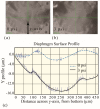Towards an Implantable, Low Flow Micropump That Uses No Power in the Blocked-Flow State
- PMID: 30404274
- PMCID: PMC6189832
- DOI: 10.3390/mi7060099
Towards an Implantable, Low Flow Micropump That Uses No Power in the Blocked-Flow State
Abstract
Low flow rate micropumps play an increasingly important role in drug therapy research. Infusions to small biological structures and lab-on-a-chip applications require ultra-low flow rates and will benefit from the ability to expend no power in the blocked-flow state. Here we present a planar micropump based on gallium phase-change actuation that leverages expansion during solidification to occlude the flow channel in the off-power state. The presented four chamber peristaltic micropump was fabricated with a combination of Micro Electro Mechanical System (MEMS) techniques and additive manufacturing direct write technologies. The device is 7 mm × 13 mm × 1 mm (<100 mm³) with the flow channel and exterior coated with biocompatible Parylene-C, critical for implantable applications. Controllable pump rates from 18 to 104 nL/min were demonstrated, with 11.1 ± 0.35 nL pumped per actuation at an efficiency of 11 mJ/nL. The normally-closed state of the gallium actuator prevents flow and diffusion between the pump and the biological system or lab-on-a-chip, without consuming power. This is especially important for implanted applications with periodic drug delivery regimens.
Keywords: Hybrid MEMs; and phase-change; direct write; gallium; implantable; integration; micropump; microsystems; peristaltic.
Conflict of interest statement
The authors declare no conflict of interest. The founding sponsors had no role in the design of the study; in the collection, analyses, or interpretation of data; in the writing of the manuscript, and in the decision to publish the results.
Figures













Similar articles
-
A nanoliter resolution implantable micropump for murine inner ear drug delivery.J Control Release. 2019 Mar 28;298:27-37. doi: 10.1016/j.jconrel.2019.01.032. Epub 2019 Jan 25. J Control Release. 2019. PMID: 30690105 Free PMC article.
-
An air-bubble-actuated micropump for on-chip blood transportation.Lab Chip. 2009 Jun 7;9(11):1524-33. doi: 10.1039/b900139e. Epub 2009 Apr 6. Lab Chip. 2009. PMID: 19458858
-
An integrated planar magnetic micropump.Microelectron Eng. 2014 Apr 1;117:35-40. doi: 10.1016/j.mee.2013.11.014. Epub 2013 Dec 19. Microelectron Eng. 2014. PMID: 33551527 Free PMC article.
-
Microelectromechanical Systems Based on Magnetic Polymer Films.Micromachines (Basel). 2022 Feb 23;13(3):351. doi: 10.3390/mi13030351. Micromachines (Basel). 2022. PMID: 35334643 Free PMC article. Review.
-
Micro Electromechanical Systems (MEMS) Based Microfluidic Devices for Biomedical Applications.Int J Mol Sci. 2011;12(6):3648-704. doi: 10.3390/ijms12063648. Epub 2011 Jun 7. Int J Mol Sci. 2011. PMID: 21747700 Free PMC article. Review.
Cited by
-
A review of peristaltic micropumps.Sens Actuators A Phys. 2021 Aug 1;326:112602. doi: 10.1016/j.sna.2021.112602. Epub 2021 Feb 10. Sens Actuators A Phys. 2021. PMID: 35386682 Free PMC article.
-
In-Vivo Microsystems: A Review.Sensors (Basel). 2020 Sep 1;20(17):4953. doi: 10.3390/s20174953. Sensors (Basel). 2020. PMID: 32883011 Free PMC article. Review.
-
Animal model studies yield translational solutions for cochlear drug delivery.Hear Res. 2018 Oct;368:67-74. doi: 10.1016/j.heares.2018.05.002. Epub 2018 May 5. Hear Res. 2018. PMID: 29793764 Free PMC article. Review.
-
A 3D-Printed Modular Microreservoir for Drug Delivery.Micromachines (Basel). 2020 Jun 30;11(7):648. doi: 10.3390/mi11070648. Micromachines (Basel). 2020. PMID: 32629848 Free PMC article.
-
Microfluidic technologies for wearable and implantable biomedical devices.Lab Chip. 2025 Aug 21. doi: 10.1039/d5lc00499c. Online ahead of print. Lab Chip. 2025. PMID: 40836841 Free PMC article. Review.
References
-
- Chen M.Y., Lonser R.R., Morrison P.F., Governale L.S., Oldfield E.H. Variables affecting convection-enhanced delivery to the striatum: A systematic examination of rate of infusion, cannula size, infusate concentration, and tissue-cannula sealing time. J. Neurosurg. 1999;90:315–320. doi: 10.3171/jns.1999.90.2.0315. - DOI - PubMed
-
- Morrison P.F., Chen M.Y., Chadwick R.S., Lonser R.R., Oldfield E.H. Focal delivery during direct infusion to brain: Role of flow rate, catheter diameter, and tissue mechanics. Am. J. Physiol. 1999;277:R1218–R1229. - PubMed
Grants and funding
LinkOut - more resources
Full Text Sources
Other Literature Sources
Miscellaneous

